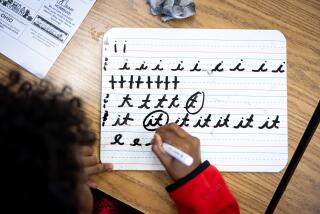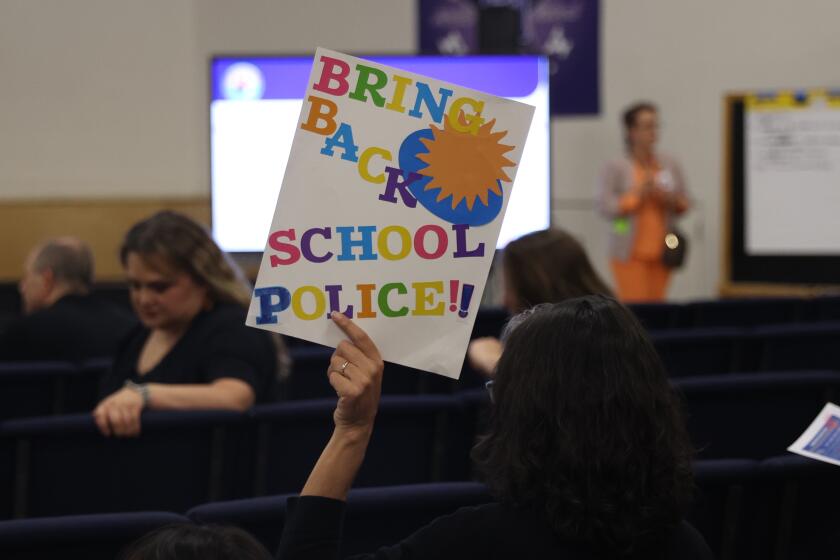Opportunity Can Be Made : Reading and Studying Shape Learning, Despite Disadvantages of Birth
What American 17-year-olds don’t know has been much in the news lately, and for good reason.
In 1986, the first national assessment of 11th-graders’ knowledge of American history and literature found most of their minds depressingly empty of essential facts about the nation’s past.
Some of the examples are by now familiar:
--One in three of the high school juniors has no clue as to when Columbus discovered America, when the Declaration of Independence was signed, who Aesop, Atlas, Cain and Abel are.
--Two out of five cannot guess the meaning of “checks and balances,” identify the country that settled the east coast of the United States, who wrote “The Iliad,” or what “The Scarlet Letter,” “Moby Dick,” or “The Red Badge of Courage” are about.
--Three out of five don’t know what the Emancipation Proclamation did or anything about “The Old Man and the Sea,” “Pride and Prejudice,” “The Grapes of Wrath,” Henry David Thoreau or Walt Whitman.
--Barely one-third can tell when Lincoln was President or in which 50-year period the Civil War was fought.
This is a sampling of the kinds of questions that together produced average scores of 55% on the history questions and 52% in literature--failing grades in anyone’s book. (And of the 8,000 students involved in the test, 80% of them were enrolled in American history class at the time.)
These lackluster averages and painful examples of ignorance have captured headlines. But what has thus far gone largely unreported may well be the most significant part of our report.
It has to do with student backgrounds and actions. Here, we turned up some of what you’d expect: Children of college-educated parents generally score highest. Asians and whites, on average, outscore blacks and Latinos. In both instances, the differences are wide.
But in both cases, there are important exceptions. For instance, 10% of the black students who took the test scored in the top quarter on history. And of all the students in the top quartile, 44% have parents who did not graduate from college. Indeed, nearly a quarter of the top students come from families where neither parent had any formal education beyond high school. The flip side is that 25% of the bottom quartile are children of college graduates.
These exceptions indicate that the circumstances of one’s birth do not predetermine one’s academic failure or success. Unpromising conditions can be overcome, and the assessment results suggest how.
Certain student behaviors and habits are clearly related to their scores regardless of race, parent education, or anything else. The less television students watch and the more regularly they attend school, the higher their scores. Predictable, sure. But note that these are things parents, teachers, policy-makers and students themselves can do something about.
There are others.
The more areas of American history that students have encountered in their course work, the higher their history scores. And the more time their English class spends on literature, the greater their knowledge of it.
Again, no surprise: Students tend to learn what is taught to them. Nor were we startled by the link between homework and knowledge. Nearly 25% of the students in the bottom quarter of the history test claim that they do not have--or do not do--homework. None. Just 12% in the top quarter make this claim. And whereas 25% of the students in the bottom quarter on the history test say that they hit the books two or more hours daily, 40% in the top quarter claim to.
The assessment showed that 11th-graders don’t read much for enjoyment. Fewer than half read for their own purpose or pleasure even once a week. Yet there is a clear correlation between leisure reading and knowledge of literature. One out of three students in the top quarter reads for pleasure on a daily basis; only one out of eight in the bottom quarter does.
It adds up to a common-sense equation: The more that youngsters read, the more regularly they attend school, and the more serious the content of what they study, the more they tend to know about history and literature.
To a significant extent, it is what students do, not just who they are, that determines how much they know. And what they do depends considerably on what the significant adults in their lives (parents and teachers, for most children) oblige them to do.
It would be wonderful if all parents read to their children, talked to them and took them to museums, concerts and plays. Of course we cannot count on all parents to instill the lore of history and love for literature in their children. But we ought to be able to rely on all of our schools to do the one thing that no other institution in this society was designed to do: transmit the knowledge that can open doors to upward mobility for the poor, the disadvantaged, minorities and anyone else. California’s newly revised history-social science curriculum takes an important step in this direction.
If we are serious about equal opportunity, we must ensure that all youngsters acquire essential cultural literacy, the elements of history and literature that will permit them to read with understanding, analyze issues, communicate ideas and participate fully in the life of their society.
This, finally, is the real message of the history and literature assessment. We’re not playing Trivial Pursuit, after all. We’re inducting young men and women into American civilization. All of them deserve a full measure of opportunity.
More to Read
Start your day right
Sign up for Essential California for news, features and recommendations from the L.A. Times and beyond in your inbox six days a week.
You may occasionally receive promotional content from the Los Angeles Times.






